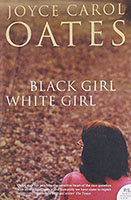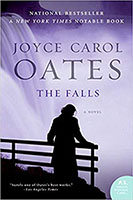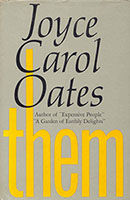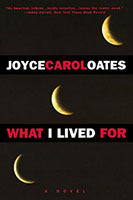She’s so prolific!” Sooner or later the remark comes up in almost any conversation about Joyce Carol Oates, who turns eighty years old in 2018 and has more than forty novels and many other books to her name. There’s usually a note of condescension in that word “prolific”—as though rapid, voluminous writing inevitably means hasty, superficial writing. After all, didn’t James Joyce labor heroically on just a handful of books? Didn’t Raymond Carver revolutionize the American short story with a few brief volumes? From T. S. Eliot to Virginia Woolf to Thomas Pynchon, authors with modest bibliographies command lofty reputations, while fast-working novelists like Anthony Trollope and John Updike come in for disparagement and even scorn. Oates’s vast output has been similarly questioned, but anyone who troubles to read a handful of her books will discover a consistent intensity and a brilliant devotion to craft. Unlike Trollope and Updike, for example, Oates creates a distinctive verbal texture for each tale she tells, whether the genre is bleak naturalism, domestic realism, social satire, Gothic horror, or fictionalized contemporary events. She designs a specific “narrative strategy,” as they say, for each world she populates, each vision she pursues. The technique is the exact opposite of a formulaic method.
And yet there will be unmistakable signs that you are reading a Joyce Carol Oates novel, beginning with what Harold Bloom calls “her immense empathy with the insulted and injured, her deep identification with the American lower classes.” Especially in early novels like A Garden of Earthly Delights (1967) and them (1969), Oates writes about poverty with a matter-of-fact intimacy, neither patronizing her characters nor using them to make a point. “She is not a political novelist,” Bloom continues, “not a social revolutionary in any merely overt way, and yet she is our true proletarian novelist” (2).
Again and again in Oates’s fiction, economic suffering results in shattered families, whether through simple neglect or in a gruesome explosion of violence. With the distinctly middle-class drama We Were the Mulvaneys (1996), however, the disintegration of the family becomes an American phenomenon without social parameters. In Oates’s world, it really doesn’t matter whether you’re rich or poor: family exerts a determining influence on character, while any given family proves fragile and short-lived.
As they emerge from these blasted homes, Oates’s characters grasp at some kind of identity. Gatsby-like, they often construct new versions of themselves, at times accomplishing complete makeovers. Jesse Harte in Wonderland (1971), Francis Brady in Middle Age: A Romance (2001), and Rebecca Schwart in The Gravedigger’s Daughter (2007) adopt new names to go with their invented selves, concealing their former identities from current friends and acquaintances. In Blonde (2000), Norma Jeane Baker submits daily to the hair stylists and makeup artists who create the fabulous product known as “Marilyn Monroe.”
What raises “the search for identity” in Oates’s novels above the level of cliché—what makes it downright subversive in our age of fashionable atheism and survey-response “nones”—is Oates’s refusal to deny her characters a spiritual dimension. They think about the state of their souls—or at least, as in American Appetites (1989), they debate the existence and nature of the soul, even while professing a brittle materialism. Middle Age, as the title suggests, involves an array of characters who pause and take stock of their lives. One divorced woman, estranged from her teenaged son, wishes she’d challenged his cocky nihilism and told him, “No, no, no. We are not pond algae. We are HUMAN, we have SOULS” (310). Whether they embrace it, deny it, or simply puzzle over it—Oates’s characters can’t stop thinking about ultimate mystery.
The answer to the banal question “Are you religious?” thus becomes an integral part of identity in Oates’s fiction. At some point, almost all her characters decide whether or not they believe in God. For many characters in contemporary fiction, by contrast, the question doesn’t even make sense. In Brazzaville Beach, for example, a 1990 novel by William Boyd, the scientist narrator is asked if she’s a Christian, and she replies impatiently, “Of course not” (263). For Oates’s characters, unbelief is rarely attained so easily. Relinquishing belief in God hurts. Teenaged Maddy of Foxfire: Confessions of a Girl Gang (1993), pondering evolution in a natural history museum, discovers “her heart’s broken” because “she can’t take God seriously ever again” (103). Proud Leah in Bellefleur (1980) rages when a terrific storm washes out her lavishly prepared party: “God has been cruel, I will never forgive Him” (322).
Unbelief seems to be the official Oates position, just as it is for the fictional Bellefleur family. On the record, Oates has dismissed faith in God as “fantastical” (Johnson 39–41), and character after character chooses science over religion, or rejects the oppressiveness and boredom of churchgoing, or simply feels too crushed by life to believe in God. Characters who do profess some kind of faith, meanwhile, run from fanatics to nominal believers to hypocrites. In Oates’s historical/Gothic novel The Accursed (2013), the Socialist writer Upton Sinclair heroically preaches secular revolution, while a benevolent old minister winds up confessing a hideous crime and accusing God of duping humanity. Such programmatic story lines—happily few in Oates’s work—reveal her debt to Marx, Freud, and Nietzsche, the great secular triumverate.
And yet for every loud assertion of unbelief, a helpless prayer seems to escape these characters. Swan, the frightening boy/man of A Garden of Earthly Delights, finds himself praying “in his mind to God, who he [understands does] not exist and never [has]” (409). Jules Wendall of them believes that “about this world there is much information, mountains of facts and wonders, but about the other world there is nothing, and so [he detaches] himself from it without regret” (105). Later, however, Jules writes to his mother and sister from a hospital, requesting their prayers and telling them he’s “certain that there is a Spirit of the Lord in us all” (326). Ariah Littrell, the minister’s daughter in The Falls (2004), renounces her faith, then bargains with God over the births of her children. With all of this, of course, Oates could simply be illustrating the old adage about atheists and foxholes. As she examines the psychology of unbelief, she includes inevitable instances of wavering. But the persistent turning to God might also indicate something deeper—not a fully ripened Christianity, certainly, nor even a nebulous theism, but nevertheless something genuine, something to do with the primal energy that makes Oates’s fiction so powerful and memorable.




Of Oates’s many
astonishing novels and stories—for once, the overworked adjective applies—What
I Lived For (1994) stands out as a major achievement. Echoing Thoreau, the
title seems to promise a sylvan meditation. Instead, Jerome “Corky” Corcoran’s
story explodes in a crowded world of hustlers, toughs, and pols, crammed into
one Memorial Day weekend in a fictionalized Buffalo, New York. Corky the Irish
city councilman and real estate developer verges on stereotypes we’ve seen many
times in fiction and film, but Oates renders her
character with such unflinching intimacy that one can’t help being swept up in
Corky’s weekend. After a somber prologue relating the mob-ordered murder of
Corky’s father when the boy was eleven, Oates jumps to the adult Corky’s point
of view, delivering a present-tense blast of profane interior monologue,
riotous misdeeds, and frantic sex. As an uncensored specimen of male libido,
Corky Corcoran makes Updike’s Rabbit Angstrom look like a choirboy.
Forty-three-year-old Corky joyously embraces surfaces. He’s proud of his hair, his suits, his shoes, his car. He disdains people who settle for cut-rate versions of the belongings that define them. “You’re an American, you’re good as you look” is his motto (94, 359). Corky grew up Catholic and attended a pricey Catholic school, but he now considers himself an atheist, shoring up his views by devouring popular science books. His religious upbringing nevertheless still permeates his thoughts, and Oates, herself no more than a nominal Catholic as a girl, imagines her way into a profoundly Catholic temperament. Corky assures himself that he’s abandoned religious belief, but the idea of God still bothers him, and he reverts repeatedly to problems of the soul and eternity.
Rushing from a tryst with his lover Christina—“What the hell do we need God for? Us?” he asks her (61)—Corky has lunch with his financial advisor Howard Greenbaum, whom he badgers with urgent questions: “What do Jews think of the universe?” “They believe in God, don’t they?” “But how did you—do you—keep people in line? Without Hell, how do you scare them?” Corky registers Greenbaum’s suave amusement, but Corky can’t help it: “for him this is serious talk” (129–32). Later during the fateful weekend, Corky wanders into a stranger’s funeral in a crematorium chapel, where the carefully neutral symbols unnerve him. No pictures of Christ, no religious images of any kind: “Corky’s shocked” (407). After the service he hastens to his car, then notices smoke billowing from a chimney overhead: “Rooted to the spot, staring upward, mouth slack, not knowing what he does Corky Corcoran makes the sign of the cross—fingertips to forehead to breast to left shoulder to right shoulder. Slowly” (409).
Is Corky just superstitious? Surely his unconscious gesture means more than that. But neither is he a deep-down Catholic in the Graham Greene mold, held fast by grace while thinking he’s damned. Even a renegade Catholicism of whiskey priests and Irish boozers is too much Catholicism for Oates. Beneath his studious atheism, and his stubborn need for ceremony and symbols, Corky harbors a wordless spiritual core, a dim spawning ground of belief.
In December 1971, during a stay in London, Oates had a mystical experience—a “sensation,” as biographer Greg Johnson describes it, “that her individuality, her ‘ego,’ had surrendered to a larger, transcendent reality” (206). She brooded over the intense revelation for months, studying various mystical traditions. This period of searching helps explain Oates’s otherwise surprising appearance at the 2004 Festival of Faith and Writing at Calvin College—not a place you’d expect to find a writer of her skeptical bent.
Her novels portray similar moments of abrupt openness to the supernatural. In Black Girl/White Girl (2006), the narrator Genna surprises her former roommate Minette, a Christian, in the middle of a candle-lighting ritual. “The candle flames were mesmerizing,” Genna recalls. “How like human souls tremulous, transparent and fleeting, this continuous burning-away, expiation and extinction.” As she continues to watch the flames, Genna is gripped by an awareness that defies the scorn of her radical activist father: “Be here now! Be here now! God is here, everywhere, now! My pulse quickened in the sudden knowledge that this was so, all that Max Meade denounced as bullshit was so, the very core of the living god that binds those who believe together yet it was not a truth that one could bear for very long, like a passionate inheld breath” (234). The Foxfire gang leader Legs Sadovsky, asked by Maddy the “official chronicler” if we have souls, replies in the final words of the novel, “Yeah probably we do but why’s that mean we’re gonna last forever? Like a flame is real enough, isn’t it, while it’s burning?—even if there’s a time it goes out?” (328). In both Black Girl/White Girl and Foxfire, candle flames signify brevity—like the brevity of Oates’s own transforming experience—yet they also convey an intense awareness of spiritual reality. Belief, or perhaps a formless precursor to belief, comes over one as a convulsive, overpowering vision.
In personal statements collected for his pioneering study The Varieties of Religious Experience (1902), William James offers scores of such critical moments. He even slips in, anonymously, his own famous episode of spiritual terror, the mental image of a helpless asylum patient who prompts James’s realization: “That shape am I” (134). For James, “whatever it may be on its farther side, the ‘more’ with which in religious experience we feel ourselves connected is on its hither side the subconscious continuation of our conscious life” (403). Mystical revelation, in other words, arrives through the buried regions of the self, in images and feelings that defy concepts and language. Oates, distrustful of creeds yet too honest for a doctrinaire materialism, supposes something like the liminal region that James hypothesizes, as her praise for Flannery O’Connor’s mysterious universe suggests (see Bloom 5-6). Crossing the Border, the title of Oates’s 1976 story collection, refers primarily to characters’ trips between the United States and Canada, but it also recalls other porous boundaries in Oates’s fiction. Jules Wendall, Corky Corcoran, and Genna Meade are all disturbed by intimations of the supernatural that mock their assured denials.
It was probably inevitable that Oates would write a novel about Niagara Falls, located near her girlhood home and for two centuries a kind of test for American writers. The Falls stand for everything we associate with Joyce Carol Oates: blind violence, primitive emotion, irresistible power. For a writer whose work is inevitably described as “a force of nature,” what better image than the ultimate display of nature’s terrible grandeur? In The Falls, Oates yokes this broadly controlling metaphor—one that conveys the achievement of her entire career—with the hidden wellsprings of religious experience. The Falls, a symbol for some of a callous, indifferent universe, evoke for others the soul’s inchoate yearning for God.
Even for Oates, whose Wonderland one blurbist referred to as her “latest shocker,” the opening sequence of The Falls is a horrifying nightmare: after a disastrous wedding night, a sexually confused young minister leaps from Goat Island into the Niagara River, leaving Ariah virtually catatonic, the “Widow-Bride of The Falls.” Swiftly wooed and won by her second husband, Ariah constructs a normal family life in the city where her first life shattered, fierce in her determination to be content and serene. She’ll have nothing more to do with God. She will cherish her husband and children. But the Falls, churning with ungovernable memories and emotions, won’t be ignored. For one thing, Ariah can’t be certain who fathered her first son, Chandler. Could it have been her tormented first husband? Then, as if by a dream-like necessity, the Falls claim her second husband through a mysterious murder. Relentless as the thundering cataract itself, her believing impulses give Ariah no rest. In aimless spasms, she visits an assortment of churches, gripped by what her second son, Royall, recalls as “religious fevers that overcame her at unexpected times, like an onslaught of flu” (284).
Ariah’s daughter, Juliet, shares her mother’s spiritual leanings. As a teenager Juliet grows obsessed with the place where her father died, lingering over the turbulent waters and identifying with a young girl of local legend who received a vision of the Virgin Mary. “Desperately, Juliet wishes to believe” in the story (428)—but when she visits a modern-day shrine commemorating the vision she finds only a tacky tourist site. Like Ariah, who becomes “bored, restless” with the “silly people” she meets in church (428), Juliet rejects the crusted layers of institutions and traditions. Instead, both mother and daughter respond to an intermittent but powerful inner urging.
Oates is no “social revolutionary,” as Bloom points out, but her stories of unbidden, barely acknowledged religious experience are the work of a courageous spiritual revolutionary. Believing and unbelieving readers alike find in her fiction a discomfiting alternate dimension. Believers know that faith involves something more than pious deeds, approved doctrines, and warm feelings—but what exactly is that something? Are we prepared to find out? Unbelievers, meanwhile, cling to orthodoxies of their own, warding off intuitions that might ruffle their neat conclusions. Oates surveys the quintessentially human, often uncomfortable territory that theists, atheists, and agnostics all share. Through almost six decades of electrifying novels and stories, she thrusts us into that inarticulate region where the soul has its dealings with God.
David Heddendorf lives in Ames, Iowa. His essays can also be found online at Front Porch Republic.
Works Cited
Bloom, Harold. “Introduction.” In Modern Critical Views: Joyce Carol Oates, edited by Harold Bloom, 1-6. New York: Chelsea House, 1987.
Boyd, William. Brazzaville Beach. New York: William Morrow, 1990.
James, William. The Varieties of Religious Experience. 1902. Cambridge, Mass.: Harvard UP, 1985.
Johnson, Greg. Invisible Writer: A Biography of Joyce Carol Oates. New York: Dutton, 1998.
Oates, Joyce Carol. A Garden of Earthly Delights. New York: Vanguard, 1967.
________. Bellefleur. New York: Dutton, 1980.
________. Black Girl/White Girl. New York: HarperCollins, 2006.
________. Foxfire: Confessions of a Girl Gang. New York: Dutton, 1993.
________. Middle Age: A Romance. New York: HarperCollins, 2001.
________. The Falls. New York: HarperCollins, 2004.
________. them. New York: Vanguard, 1969.
________. What I Lived For. New York: Dutton, 1994.













